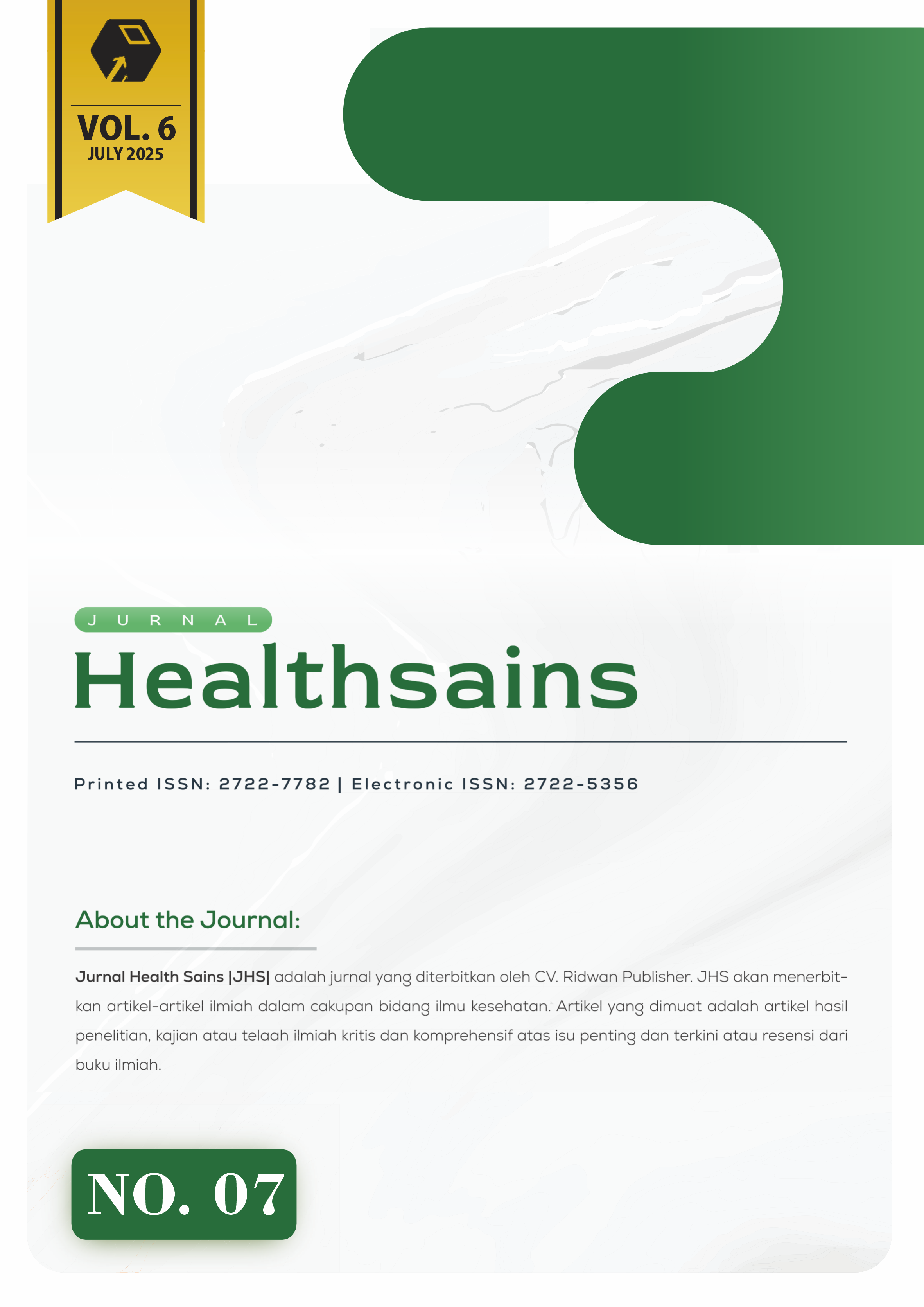The Relationship Between Occupation and Incidence of Various Types of Melanocytic Nevi
DOI:
https://doi.org/10.46799/jhs.v6i7.2671Keywords:
Melanocytic nevus, occupation, types of melanocytic nevusAbstract
Melanocytic nevi (MN) are benign proliferations of melanocytes influenced by genetic and environmental factors, particularly ultraviolet (UV) radiation. Occupational exposure to sunlight may contribute to the development of different nevus types, but this relationship remains underexplored. This study aimed to examine the association between occupation and the incidence of various melanocytic nevi types. A descriptive observational study with a cross-sectional design was conducted among 20 participants in Semarang, Indonesia, from April to May 2025. Data were collected via validated questionnaires covering occupation (indoor/outdoor), protective measures (sunscreen, long-sleeved clothing), and nevus types (junctional, compound, intradermal). Statistical analysis was performed using SPSS. Results showed that 60% of participants had indoor occupations, while 40% worked outdoors. Among nevus types, 50% had compound nevi, 16% had junctional nevi, and 10% had intradermal nevi. A significant association was found between outdoor occupations and compound nevi (p = 0.010, RR = 3.50). No significant links were observed for junctional or intradermal nevi. Protective measures, such as sunscreen use, showed no significant impact, possibly due to low adherence (70% non-users). The findings suggest that occupational UV exposure may elevate the risk of compound nevi. Further research with larger samples and additional variables (e.g., sun exposure duration) is recommended to validate these results and to inform preventive strategies for at-risk populations.
References
Black, S., MacDonald-Mcmillan, B., Mallett, X., Rynn, C., & Jackson, G. (2020a). The incidence and position of melanocytic nevi for the purposes of forensic image comparison. International Journal of Legal Medicine, 128(3), 535–543. https://doi.org/10.1007/s00414-013-0821-z
Black, S., MacDonald-Mcmillan, B., Mallett, X., Rynn, C., & Jackson, G. (2020b). The incidence and position of melanocytic nevi for the purposes of forensic image comparison. International Journal of Legal Medicine, 128(3), 535–543. https://doi.org/10.1007/s00414-013-0821-z
Dessinioti, C., Geller, A. C., Stergiopoulou, A., Dimou, N., Lo, S., Keim, U., Gershenwald, J. E., Haydu, L. E., Dummer, R., Mangana, J., Hauschild, A., Egberts, F., Vieira, R., Brinca, A., Zalaudek, I., Deinlein, T., Evangelou, E., Thompson, J. F., Scolyer, R. A., … Stratigos, A. J. (2021). A multicentre study of naevus-associated melanoma vs. de novo melanoma, tumour thickness and body site differences*. British Journal of Dermatology, 185(1). https://doi.org/10.1111/bjd.19819
Frischhut, N., Zelger, B., Andre, F., & Zelger, B. G. (2022). The spectrum of melanocytic nevi and their clinical implications. Journal Der Deutschen Dermatologischen Gesellschaft, 20(4), 483. https://doi.org/10.1111/DDG.14776
Hendrayanta, M., & Darmaputra, I. G. N. (2024). Karakteristik Pasien Dengan Tumor Jinak Melanositik Pada Rumah Sakit Umum Pusat Prof Dr Igng Ngoerah Periode Januari 2020 – Desember 2022. E-Jurnal Medika Udayana, 13(1), 76. https://doi.org/10.24843/mu.2024.v13.i01.p15
Kang, S, dkk. (2019). Fitzpatrick’s Dermatology, 9th Edition, 2 Volume Set. Nucl. Phys., 13(1).
Liu, P., Su, J., Zheng, X., Chen, M., Chen, X., Li, J., Peng, C., Kuang, Y., & Zhu, W. (2021a). A Clinicopathological Analysis of Melanocytic Nevi: A Retrospective Series. Frontiers in Medicine, 8, 681668. https://doi.org/10.3389/FMED.2021.681668/BIBTEX
Liu, P., Su, J., Zheng, X., Chen, M., Chen, X., Li, J., Peng, C., Kuang, Y., & Zhu, W. (2021b). A Clinicopathological Analysis of Melanocytic Nevi: A Retrospective Series. Frontiers in Medicine, 8, 681668. https://doi.org/10.3389/FMED.2021.681668/FULL
Muradia, I., Khunger, N., & Yadav, A. K. (2022). A Clinical, Dermoscopic, and Histopathological Analysis of Common Acquired Melanocytic Nevi in Skin of Color. Journal of Clinical and Aesthetic Dermatology, 15(10), 41–51.
Nagarathinam, S., & Baalann, K. P. (2021). Nevus pigmentosus et pilosus. In Pan African Medical Journal (Vol. 40). https://doi.org/10.11604/pamj.2021.40.107.26779
Sjambali, S., Rahmayani, S., Wirohadidjojo, Y. W., & Danarti, R. (2019). Nevus Melanositik Kongenital Luas Laporan Kasus Dan Telaah Literatur. Media Dermato-Venereologica Indonesiana, 45(3). https://doi.org/10.33820/mdvi.v45i3.28
Sun, X., Zhang, N., Yin, C., Zhu, B., & Li, X. (2020). Ultraviolet Radiation and Melanomagenesis: From Mechanism to Immunotherapy. Frontiers in Oncology, 10, 539431. https://doi.org/10.3389/FONC.2020.00951/XML/NLM
Sutedja, E. K., Wulandini, N., & Mayasari, W. (2020). Gambaran Klinis Karsinoma Sel Basal di Poli Tumor dan Bedah Kulit RSUP Dr. Hasan Sadikin Tahun 2014-2017. Media Dermato Venereologica Indonesiana, 49(3).
Tsaniyah, D., Aspitriani, & Fatmawati. (2015). Prevalensi dan Gambaran Histopatologi Nevus Pigmentosus. Majalah Kedokteran Sriwijaya, 47(2), 110–114.
Yeh, I. (2020a). New and Evolving Concepts of Melanocytic Nevi and Melanocytomas. Modern Pathology, 33, 1–14. https://doi.org/10.1038/s41379-019-0390-x
Yeh, I. (2020b). New and Evolving Concepts of Melanocytic Nevi and Melanocytomas. Modern Pathology, 33, 1–14. https://doi.org/10.1038/s41379-019-0390-x
Downloads
Published
Issue
Section
License
Copyright (c) 2025 Puguh Riyanto, Lim Alexander

This work is licensed under a Creative Commons Attribution-ShareAlike 4.0 International License.
Authors who publish with this journal agree to the following terms:
- Authors retain copyright and grant the journal right of first publication with the work simultaneously licensed under aCreative Commons Attribution-ShareAlike 4.0 International (CC-BY-SA). that allows others to share the work with an acknowledgement of the work's authorship and initial publication in this journal.
- Authors are able to enter into separate, additional contractual arrangements for the non-exclusive distribution of the journal's published version of the work (e.g., post it to an institutional repository or publish it in a book), with an acknowledgement of its initial publication in this journal.
- Authors are permitted and encouraged to post their work online (e.g., in institutional repositories or on their website) prior to and during the submission process, as it can lead to productive exchanges, as well as earlier and greater citation of published work.






